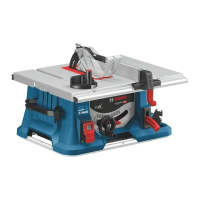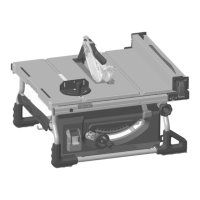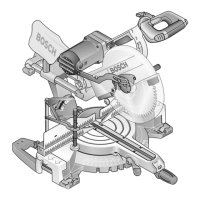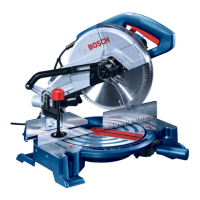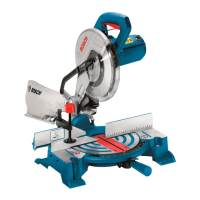English | 37
Bosch Power Tools 1 609 929 X57 | (12/5/11)
Starting Operation
f Observe the mains voltage! The voltage of the power
source must correspond with the data on the type plate of
the machine.
Switching On (see figure I1)
– Tilt safety flap 21 upward.
– To start the operation, press the green ON button 66.
Switching Off (see figure I2)
– Press on the safety flap 21.
Power Failure
The ON/OFF switch is a so-called non-voltage switch, which
prevents the power tool from restarting after a power failure
(e. g., when the mains plug is pulled during operation).
To restart the operation of the machine afterwards, the green
ON button 66 must be pressed again.
Working Advice
General Sawing Instructions
f For all cuts, it must first be ensured that the saw blade
at no time can come in contact with the stops or other
machine parts.
f Use the machine for grooving or rebating only with an
appropriately suitable protective device (e. g. a tunnel
blade guard).
f Do not use the machine for cutting slots (stopped
grooves).
Protect the saw blade against impact and shock. Do not sub-
ject the saw blade to lateral pressure.
The riving knife must be in alignment with the saw blade to
avoid jamming of the workpiece.
Do not saw warped/bent workpieces. The workpiece must al-
ways have a straight edge to face against the parallel guide.
Always keep/store the push stick with the power tool.
Position of the Operator (see figure J)
f Do not stand in a line with the saw blade in front of the
machine. Always stand aside of the saw blade. This pro-
tects your body against possible kickback.
– Keep hands, fingers and arms away from the rotating saw
blade.
Observe the following instructions:
– Hold the workpiece securely with both hands and press it
firmly against the saw table.
– When sawing narrow workpieces and bevel angles, always
use the supplied hold-down stick 13 and the auxiliary par-
allel guide 49.
Marking the Cutting Line (see figure K)
– Mark the saw blade width on the round yellow sticker 33.
This allows for exact positioning of the workpiece for saw-
ing, without having to open the blade guard.
Maximum Workpiece Dimensions
Sawing
Sawing Straight Cuts
– Adjust the parallel guide 8 to the requested cutting width.
(see “Adjusting the Parallel Guide”, page 36)
– Position the workpiece on the saw table in front of the
blade guard 5.x.
– Raise or lower the saw blade with the crank 20 so that the
upper saw teeth project approx. 5 mm above the work-
piece surface.
– Adjust the blade guard according to the workpiece height.
When sawing, the blade guard must always face lightly
against the workpiece.
– Switch on the machine.
– Saw through the workpiece applying uniform feed.
– Switch off the machine and wait until the saw blade has
come to a complete stop.
Sawing Bevel Angles
– Adjust the desired bevel angle. (see “Adjusting Bevel An-
gles”, page 36)
– Follow the worksteps in section “Sawing Straight Cuts” ac-
cordingly.
Sawing Mitre Angles (see figure L)
– Adjust the requested mitre angle (see “Adjusting Mitre An-
gles”, page 36)
– Place the workpiece against profile rail 34.
The profile may not be on the cutting line. If so, loosen
knurled nut 53 and move the profile.
– Raise or lower the saw blade with the crank 20 so that the
upper saw teeth project approx. 5 mm above the work-
piece surface.
– Adjust the blade guard according to the workpiece height.
When sawing, the blade guard must always face lightly
against the workpiece.
– Switch on the machine.
– With one hand, press the workpiece against the profile rail
and with the other hand, slowly move the angle stop via
locking knob 62 toward the front in guide groove 9.
– Switch off the machine and wait until the saw blade has
come to a complete stop.
Sawing Mitre Angles with the Sliding Table Locked
– Adjust the requested mitre angle (see “Adjusting Mitre An-
gles”, page 36)
– The angle stop must move freely in the guide groove 9 (left-
ward or rightward).
For this, loosen knurled screw 51, if required.
– Follow the worksteps in section “Sawing Straight Cuts” ac-
cordingly.
Sawing Mitre Angles with the Sliding Table
– Adjust the requested mitre angle (see “Adjusting Mitre An-
gles”, page 36)
Bevel angle Max. workpiece height
[mm]
0° 79
45°
56
OBJ_BUCH-1375-001.book Page 37 Thursday, May 12, 2011 2:22 PM

